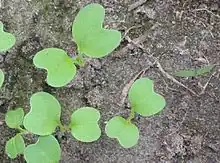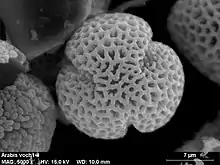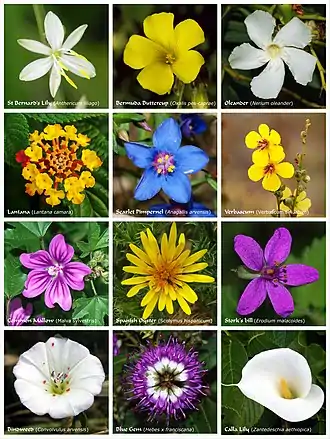| Eudicots Temporal range: | |
|---|---|
 | |
| Two seed leaves during germination (Brassica sp.) | |
| Scientific classification | |
| Kingdom: | Plantae |
| Clade: | Streptophyta |
| Clade: | Embryophytes |
| Clade: | Polysporangiophytes |
| Clade: | Tracheophytes |
| Clade: | Spermatophytes |
| Clade: | Angiosperms |
| Clade: | Eudicots |
| Clades (APG IV) | |
| |

The eudicots, Eudicotidae, or eudicotyledons are a clade of flowering plants mainly characterized by having two seed leaves upon germination.[1] The term derives from Dicotyledons.
Traditionally they were called tricolpates or non-magnoliid dicots by previous authors. The botanical terms were introduced in 1991 by evolutionary botanist James A. Doyle and paleobotanist Carol L. Hotton to emphasize the later evolutionary divergence of tricolpate dicots from earlier, less specialized, dicots.[2]
Numerous familiar plants are eudicots, including many common food plants, trees, and ornamentals. Some common and familiar eudicots include sunflower, dandelion, forget-me-not, cabbage, apple, buttercup, maple, and macadamia. Most leafy trees of midlatitudes also belong to eudicots, with notable exceptions being magnolias and tulip trees which belong to the magnoliids, and Ginkgo biloba, which is not an angiosperm.
Description
The close relationships among flowering plants with tricolpate pollen grains was initially seen in morphological studies of shared derived characters. These plants have a distinct trait in their pollen grains of exhibiting three colpi or grooves paralleling the polar axis.[3]
Later molecular evidence confirmed the genetic basis for the evolutionary relationships among flowering plants with tricolpate pollen grains and dicotyledonous traits. The term means "true dicotyledons", as it contains the majority of plants that have been considered dicots and have characteristics of the dicots. One of the genetic traits which defines the eudicots is the duplication of DELLA protein‐encoding genes in their most recent common ancestor.[4] The term "eudicots" has subsequently been widely adopted in botany to refer to one of the two largest clades of angiosperms (constituting over 70% of the angiosperm species), monocots being the other. The remaining angiosperms include magnoliids and what are sometimes referred to as basal angiosperms or paleodicots, but these terms have not been widely or consistently adopted, as they do not refer to a monophyletic group.
Taxonomy
The earlier name for the eudicots is tricolpates, a name which refers to the grooved structure of the pollen. Members of the group have tricolpate pollen, or forms derived from it. These pollens have three or more pores set in furrows called colpi. In contrast, most of the other seed plants (that is the gymnosperms, the monocots and the paleodicots) produce monosulcate pollen, with a single pore set in a differently oriented groove called the sulcus. The name "tricolpates" is preferred by some botanists to avoid confusion with the dicots, a nonmonophyletic group.[5]
The name "eudicots" (plural) is used in the APG systems (from APG system, of 1998, to APG IV system, of 2016) for classification of angiosperms. It is applied to a clade, a monophyletic group, which includes most of the (former) dicots.
"Tricolpate" is a synonym for the "Eudicot" monophyletic group, the "true dicotyledons" (which are distinguished from all other flowering plants by their tricolpate pollen structure). The number of pollen grain furrows or pores helps classify the flowering plants, with eudicots having three colpi (tricolpate), and other groups having one sulcus.[6][5]
Pollen apertures are any modification of the wall of the pollen grain. These modifications include thinning, ridges and pores, they serve as an exit for the pollen contents and allow shrinking and swelling of the grain caused by changes in moisture content. The elongated apertures/ furrows in the pollen grain are called colpi (singular colpus), which, along with pores, are a chief criterion for identifying the pollen classes.[7]
Subdivisions
The eudicots can be divided into two groups: the basal eudicots and the core eudicots.[8] Basal eudicot is an informal name for a paraphyletic group. The core eudicots are a monophyletic group.[9] A 2010 study suggested the core eudicots can be divided into two clades, Gunnerales and a clade called Pentapetalae, comprising all the remaining core eudicots.[10]
The Pentapetalae can be then divided into three clades:
- Dilleniales
- superrosids consisting of Saxifragales and rosids (the APG IV system includes the Vitales in the rosids)
- superasterids consisting of Santalales, Berberidopsidales, Caryophyllales and asterids
This division of the eudicots is shown in the following cladogram:[11]
| eudicots |
| ||||||||||||||||||||||||||||||||||||||||||||||||||||||||||||||||||||||||||||||
The following is a more detailed breakdown according to APG IV, showing within each clade and orders:[12]
- clade Eudicots
- order Ranunculales
- order Proteales
- order Trochodendrales
- order Buxales
- clade Core eudicots
- order Gunnerales
- order Dilleniales
- clade Superrosids
- order Saxifragales
- clade Rosids
- order Vitales
- clade Fabids
- order Fabales
- order Rosales
- order Fagales
- order Cucurbitales
- order Oxalidales
- order Malpighiales
- order Celastrales
- order Zygophyllales
- clade Malvids
- order Geraniales
- order Myrtales
- order Crossosomatales
- order Picramniales
- order Malvales
- order Brassicales
- order Huerteales
- order Sapindales
- clade Superasterids
- order Berberidopsidales
- order Santalales
- order Caryophyllales
- clade Asterids
- order Cornales
- order Ericales
- clade Campanulids
- order Aquifoliales
- order Asterales
- order Escalloniales
- order Bruniales
- order Apiales
- order Dipsacales
- order Paracryphiales
- clade Lamiids
- order Solanales
- order Lamiales
- order Vahliales
- order Gentianales
- order Boraginales
- order Garryales
- order Metteniusales
- order Icacinales
References
- ↑ "EUDICOTS". Basic Biology. Basic Biology 2020. Retrieved 6 July 2020.
- ↑ Endress, Peter K. (2002). "Morphology and Angiosperm Systematics in the Molecular Era" (PDF). Botanical Review. Structural Botany in Systematics: A Symposium in Memory of William C. Dickison. 68 (4): 545–570. doi:10.1663/0006-8101(2002)068[0545:maasit]2.0.co;2. JSTOR 4354438. S2CID 39486751.
- ↑ Furness, Carol A.; Rudall, Paula J. (March 2004). "Pollen aperture evolution – a crucial factor for eudicot success?". Trends in Plant Science. 9 (3): 154–158. doi:10.1016/j.tplants.2004.01.001. PMID 15003239.
- ↑ Phokas, A.; Coates, J. C. (2021). "Evolution of DELLA function and signaling in land plants". Evolution & Development. 23 (3): 137–154. doi:10.1111/ede.12365. PMC 9285615. PMID 33428269.
- 1 2 Judd & Olmstead 2004
- ↑ Sporne, Kenneth R. (1972). "Some Observations on the Evolution of Pollen Types in Dicotyledons". New Phytologist. 71 (1): 181–5. doi:10.1111/j.1469-8137.1972.tb04826.x.
- ↑ Davis, Owen (1999). "Pollen Aperture Definitions". University of Arizona - Geosciences. Archived from the original on 2009-02-03. Retrieved 2009-02-16.
- ↑ Worberg, A; Quandt, D; Barniske, A-M; Löhne, C; Hilu, KW; Borsch, T (2007). "Phylogeny of basal eudicots: insights from non-coding and rapidly evolving DNA". Organisms Diversity & Evolution. 7 (1): 55–77. doi:10.1016/j.ode.2006.08.001.
- ↑ Soltis, Douglas E.; Soltis, Pamela S.; Endress, Peter K.; Chase, Mark W. (2005). Phylogeny and Evolution of Angiosperms. Sunderland, MA: Sinauer Associates. ISBN 9780878938179.
- ↑ Moore, Michael J.; Soltis, Pamela S.; Bell, Charles D.; Burleigh, J. Gordon & Soltis, Douglas E. (2010). "Phylogenetic analysis of 83 plastid genes further resolves the early diversification of eudicots". Proceedings of the National Academy of Sciences. 107 (10): 4623–8. Bibcode:2010PNAS..107.4623M. doi:10.1073/pnas.0907801107. PMC 2842043. PMID 20176954.
- ↑ Based on:
Stevens, P.F. (2001–2014). "Trees". Angiosperm Phylogeny Website. Retrieved 2014-11-17.
Stevens, P.F. (2001–2016). "Eudicots". Angiosperm Phylogeny Website. Retrieved 2014-11-17. - ↑ Angiosperm Phylogeny Group (2016). "An update of the Angiosperm Phylogeny Group classification for the orders and families of flowering plants: APG IV". Botanical Journal of the Linnean Society. 181 (1): 1–20. doi:10.1111/boj.12385.
Bibliography
- Doyle, J.A.; Hotton, C.L. (1991). "Diversification of early angiosperm pollen in a cladistic context". In Blackmore, S.; Barnes, S.H. (eds.). Pollen and Spores. Patterns of Diversification. Systematics Association Publications. Vol. 44. Clarendon Press. pp. 169–195. ISBN 9780198577461.
- Judd, Walter S.; Olmstead, Richard G. (2004). "A survey of tricolpate (eudicot) phylogenetic relationships". American Journal of Botany. 91 (10): 1627–44. doi:10.3732/ajb.91.10.1627. PMID 21652313.
- Eudicots in Stevens, P. F. (2001 onwards). Angiosperm Phylogeny Website. Version 7, May 2006.
External links
- "Eudicots" at the Encyclopedia of Life
- Eudicots, Tree of Life Web Project
- Dicots Archived 2015-02-24 at the Wayback Machine Plant Life Forms
